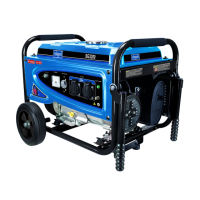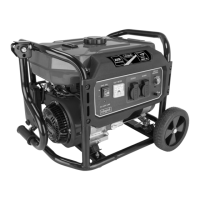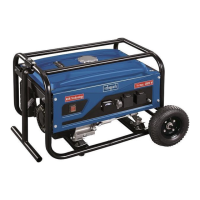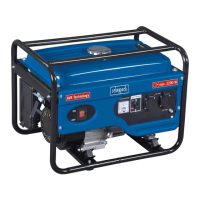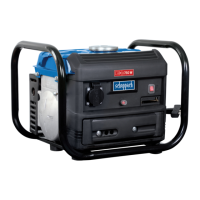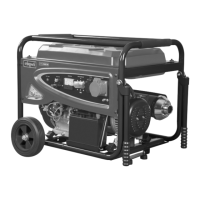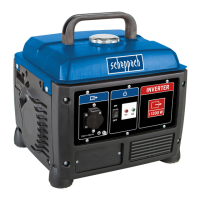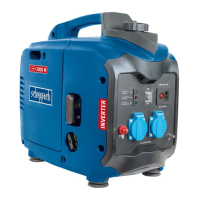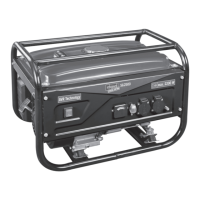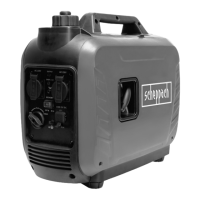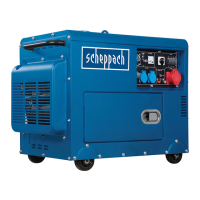www.scheppach.com
GB
|
33
When the engine is cold
1. Attention! Never allow the pull starter (5) to whip
back. This can result in damage.
2. Set the on/o switch (11) to the “CHOKE” position.
3. Now pull the pull starter (5) and the engine should
start. If the engine does not start, repeat the pro-
cess.
4. Move the on/o switch (11) from the “CHOKE” po-
sition to the “RUN” position after starting the en-
gine (after approx. 15-30 seconds). (Fig. 6)
5. If the engine does not start even after several at-
tempts, read the “Troubleshooting” chapter.
Note:
If the engine is being started for the rst time, several
tries are required to start until the fuel has been deliv-
ered from the tank to the engine.
Note: With high outside temperatures, it may be nec-
essary to start the power generator without the choke
even when the engine is cold!
When the engine is warm
1. Set the on/o switch (11) to the “RUN” position.
2. Now pull the pull starter (5) quickly. The device
should start after a maximum of 2 pulls. If the
device has still not started, repeat the procedure
described under “Starting the engine when cold”.
9.2 Shutting the engine o
Allow the power generator to run for a short time (ap-
prox. 30 seconds) without load before switching it o so
that it can “cool down”.
1. Set the on/o switch (11) to the “OFF” position.
2. Disconnect the power consumers from the device.
3. Set the ventilation on the tank cover (2) to “OFF”.
9.3 Operating display (6) (Fig. 3)
The operating display (6) is active when the engine is
running.
9.4 Overload indicator (7) (Fig. 3)
The overload protection becomes active if the power
consumption is too high and switches o the 230 V ~
sockets (13).
1. Switch the device o as described in section 9.2.
2. Disconnect the power consumers from the device.
8. If the oil level is too low, add the recommended
amount of oil (max. 400 ml).
9. Then screw the oil dipstick (20) in again.
10. Put the engine cover (3) on and x in place by
retightening the two screws.
8.3 Rell with fuel
m Attention!
The power generator is delivered without petrol. It
is therefore essential to ll with petrol before com-
missioning. Use Super E10 petrol for this.
1. Unscrew the tank ller cap (2) and ll a maximum
of 6.3 l Super E10 petrol into the tank container
using the funnel (17).
2. Ensure that the tank is not overlled (observe the
ll level marking (26)!) and that no petrol is spilled.
Use a fuel lter insert (25). Clean up spilled petrol
immediately and wait until the fuel vapours have
evaporated (wipe dry).
3. Close the tank cover (2).
m ATTENTION!
Refuel in a well-ventilated area with the engine
stopped.
If the engine was in operation immediately before,
allow it to cool rst. Never refuel the engine in a
building where the petrol vapour may come into
contact with ames or sparks.
Petrol is highly inammable and explosive. When
handling fuels, you may suer burns or other se-
vere injuries.
9. Operation
m Attention!
Always make sure the device is fully assembled
before commissioning!
9.1 Starting the engine (Fig. 5 + 6)
m Attention! Danger of poisoning!
Only use the device outdoors and never in closed or
poorly ventilated rooms.
1. Set the ventilation on the tank cover (2) to “ON”.
2. Set the on/o switch (11) to the “RUN” position.
Note: The energy saving switch (10) must be set to
“OFF”.
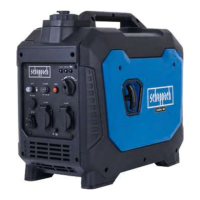
